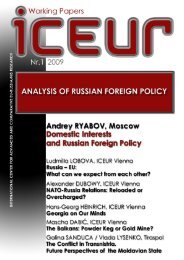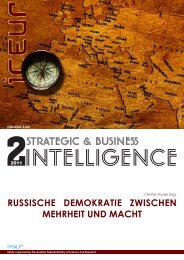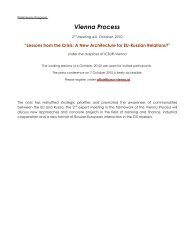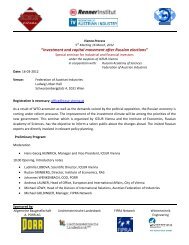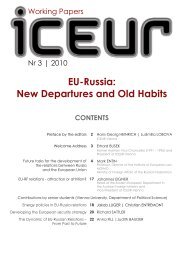Address - International Center for Advanced and Comparative EU ...
Address - International Center for Advanced and Comparative EU ...
Address - International Center for Advanced and Comparative EU ...
Create successful ePaper yourself
Turn your PDF publications into a flip-book with our unique Google optimized e-Paper software.
Michael LÖWY<br />
Current Developments in Austria <strong>and</strong> the CEE<br />
Bosnia-Herzegovina, Slovenia, Bulgaria, Romania, Serbia <strong>and</strong> Croatia, <strong>and</strong> rank third in Slovakia, the<br />
Czech Republic, Hungary <strong>and</strong> Macedonia.<br />
In a nutshell, Austria has seen an excellent development over the past 2 decades. Today, 20 years after the<br />
dismantling of the Iron Curtain, we should not <strong>for</strong>get that this success story would have been impossible<br />
without open borders.<br />
The CEE countries will continue their dynamic development in the years to come. In fact his region<br />
continues to have strong benchmark data <strong>and</strong> excellent long-term growth <strong>and</strong> per<strong>for</strong>mance prospects. The<br />
process of catching up will take at least another two generations, <strong>and</strong> according to IMF estimates, in 2001,<br />
growth rates in the region will be 2 % above those of the “West” again.<br />
Frequent contacts with our industrial companies operating in the region, our sister federations, as well as the<br />
statistical data available to us, confirm our assessment of the situation. The countries of Central <strong>and</strong> Eastern<br />
Europe continue to be our markets of the future. This also holds <strong>for</strong> the Caspian <strong>and</strong> Black Sea regions with<br />
the huge markets of Turkey <strong>and</strong> especially Russia.<br />
If we were to lose sight of the enormous potential of this region in the current crisis, we would be acting<br />
against our own interests. In fact, the CEECs have highly efficient industrial facilities, a competitive wage<br />
level <strong>and</strong> a well-trained, flexible <strong>and</strong> dynamic labour <strong>for</strong>ce. Moreover, rumours about the excessive level of<br />
debt of households <strong>and</strong> enterprises are unjustified. Furthermore, the volume of loans to households <strong>and</strong><br />
enterprises in the CEECs lies between 30 % <strong>and</strong> a maximum of 80 % of GDP. The corresponding average in<br />
the Euro currency area lies at 125 % of GDP.<br />
We must make every ef<strong>for</strong>t to keep the “Central <strong>and</strong> Eastern European growth engine” running <strong>and</strong> maintain<br />
our presence in the region throughout these turbulent times. This is not without risks, but, above all, full of<br />
great opportunities. If we succeed in our ef<strong>for</strong>ts, the success story of the past 20 years will be continued.<br />
Against this background, we welcome the package of rescue measures <strong>for</strong> countries in distress adopted by<br />
the <strong>EU</strong> <strong>and</strong> the IMF during the first half of this year. This is a course which needs to be consistently pursued<br />
in order to build liquidity <strong>and</strong> strengthen the economy as a whole.<br />
In this context it is essential to advance the process of European integration. We must not allow economic<br />
developments to put a lasting halt to future enlargements. We continue to advocate Croatia's speedy<br />
accession to the <strong>EU</strong> <strong>and</strong> support the European integration of the Western Balkan states with the objective of<br />
future <strong>EU</strong> accession.<br />
In addition, not only do we want our own companies to succeed in the Eastern European markets, we also<br />
hope to attract successful companies from that region as investors <strong>for</strong> Austria. To reach this goal, we will<br />
need an investor-friendly fiscal policy, a more liberal visa policy as well as the early creation of sustainable<br />
networks, such as scholarship programmes.<br />
The Federation of Austrian Industries itself has been cooperating closely with industry <strong>and</strong> employer<br />
federations in Central <strong>and</strong> Eastern Europe <strong>for</strong> several years. We have been developing common positions on<br />
crucial industry-policy issues, such as energy <strong>and</strong> climate policy, international trade <strong>and</strong> the need <strong>for</strong> fast<br />
infrastructure modernization, above all between the Central European centres of economic activity.<br />
Moreover, our Federation is a member of UBCCE, the Union of Black Sea <strong>and</strong> Caspian Confederation of<br />
Enterprises, a structure still in its early years. Through these contacts, we hope to intensify our relations with<br />
political <strong>and</strong> economic decision-makers in the region.<br />
In conclusion, let me underline once again that we look with confidence to the further intensification of our<br />
economic relations with Eastern Europe. Regardless of the current crisis, we are determined to continue our<br />
activities in the region.<br />
For us, the economic development of Eastern Europe is just as paramount as that of Austria. Only a prospering<br />
Central Europe <strong>and</strong> a strong <strong>and</strong> efficient European Union which prioritizes competitiveness in the framework of<br />
an integrated industrial policy, will guarantee growth <strong>and</strong> prosperity in Europe <strong>and</strong> Austria<br />
IC<strong>EU</strong>R-Vienna Working Papers 2|2009 19



